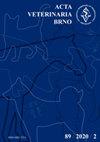Translocation stress is reflected in corticosterone metabolites in pheasant (Phasianus colchicus) droppings
IF 0.7
4区 农林科学
Q3 VETERINARY SCIENCES
引用次数: 4
Abstract
Translocation (including transportation and experiencing a new environment) represents a significant stressor for animals. The aim of this study was to assess changes in corticosterone metabolite (CM) levels related to translocation in common pheasants (Phasianus colchicus). Sixteen birds (8 males and 8 females) aged 17 weeks were crated and transported for 3.5 h (distance travelled 140 km) to the target customer. Serial individual droppings were collected from 2 days prior until 3 days after transport. Concentrations of CMs in droppings were determined with a non-commercial cortisone enzyme immunoassay (EIA). Transport stress resulted in increased CM concentrations in the droppings in our study. The CM concentrations significantly increased within 2.5 h of transport (P < 0.01) compared to pre-transport levels (747 ng/g vs. 187 ng/g). After additional 3 h, the CM concentrations fell back to the baseline levels (207.7 ng/g). In the new environment, the second peak (median: 1383 ng/g) was determined with CM concentrations increasing (P < 0.01) compared to baseline levels. This increase was likely connected to the stress resulting from the new environment. The CM levels returned back to the baseline level 26 h after the start of transportation. No differences in concentrations of CM between sexes were found in our study. The utilized cortisone EIA proved suited to detect biologically meaningful alterations in adrenocortical activity of pheasants exposed to procedures related to their transport.易位应激反映在野鸡粪便中的皮质酮代谢物中
易位(包括运输和体验新环境)是动物的重要压力源。本研究的目的是评估与普通野鸡(Phasianus colchicus)易位相关的皮质酮代谢物(CM)水平的变化。16只17周龄的鸟(8公8母)被装箱,运输3.5小时(行程140公里)到达目标客户。从运输前2天至运输后3天连续收集个体粪便。采用非商业可的松酶免疫分析法(EIA)测定粪便中CMs的浓度。在我们的研究中,运输胁迫导致粪便中CM浓度增加。与转运前相比,转运2.5 h内CM浓度显著升高(P < 0.01) (747 ng/g vs. 187 ng/g)。3 h后,CM浓度回落至基线水平(207.7 ng/g)。在新环境中,第二峰(中位数:1383 ng/g)出现,与基线水平相比,CM浓度增加(P < 0.01)。这种增加可能与新环境带来的压力有关。运输开始26 h后,CM水平恢复到基线水平。在我们的研究中没有发现两性之间CM浓度的差异。所利用的可的松EIA证明适合于检测暴露于其运输相关程序的野鸡肾上腺皮质活性的生物学意义改变。
本文章由计算机程序翻译,如有差异,请以英文原文为准。
求助全文
约1分钟内获得全文
求助全文
来源期刊

Acta Veterinaria Brno
农林科学-兽医学
CiteScore
1.00
自引率
33.30%
发文量
36
审稿时长
18-36 weeks
期刊介绍:
ACTA VETERINARIA BRNO is a scientific journal of the University of Veterinary and Pharmaceutical Sciences in Brno, Czech Republic.
The scientific journal Acta Veterinaria Brno is dedicated to the publication of original research findings and clinical observations in veterinary and biomedical sciences. Original scientific research articles reporting new and substantial contribution to veterinary science and original methods that have not been submitted for publication elsewhere are considered for publication. A written statement to this effect should accompany the manuscript, along with approval for publication by the author´s head of department. The authors bear full responsibility for the contents of their contribution. Book reviews are published, too.
 求助内容:
求助内容: 应助结果提醒方式:
应助结果提醒方式:


